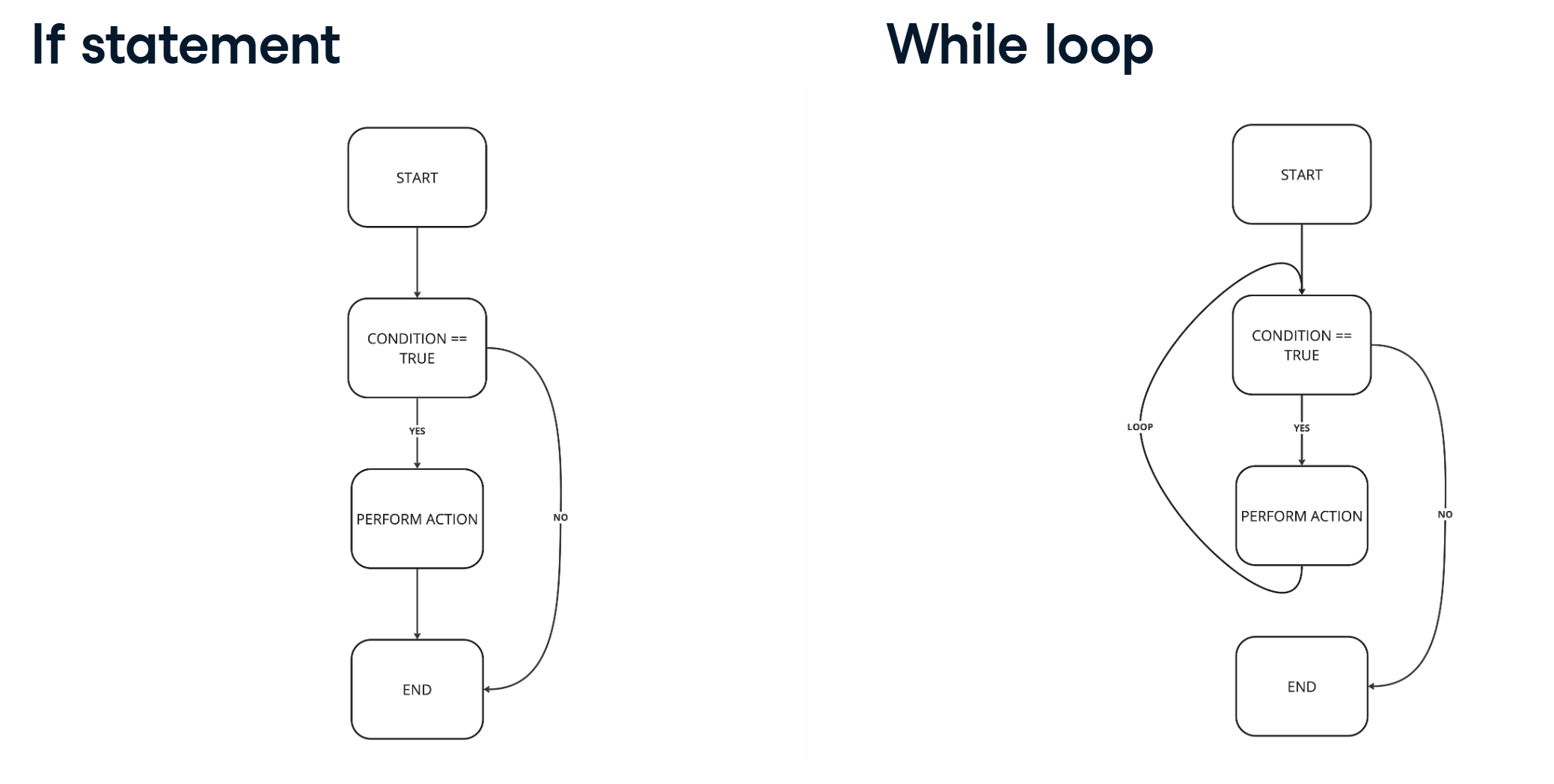Loops
For Loop
A For Loop iterates over a sequence (like a list or a string).
Looping Through a List
This loop prints each price in the list.
prices = [12, 4, 8, 15]
for price in prices:
print(price)
Output:
12
4
8
15
Conditional Statements
You can combine if, elif, and else with loops to make decisions.
prices = [12, 4, 8, 15]
for price in prices:
if price > 10:
print("More than 10 dollars")
elif price < 5:
print("Less than 5 dollars")
else:
print("Between 5 and 10 dollars")
Output:
More than 10 dollars
Less than 5 dollars
Between 5 and 10 dollars
More than 10 dollars
The loop checks each price and prints the range.
Looping Through Strings
You can loop through each character in a string just like you do with lists.
username = "Alice"
for char in username:
print(char)
Output:
A
l
i
c
e
Looping Through Dictionaries
Use .items() to loop through both keys and values in a dictionary.
You can also loop through just keys with .keys() or just values with .values().
user_info = {"name": "Alice", "age": 30}
for key, value in user_info.items():
print(key, ":", value)
Output:
name : Alice
age : 30
Using Range
The range() function generates a sequence of numbers, useful for loops that involve counting.
for i in range(1, 6):
print(i)
Output:
1
2
3
4
5
Building a Counter
You can update variables within a loop, such as counting occurrences.
visits = 0
for i in range(1, 11):
visits += 1
print(visits)
Output:
10
The loop counts from 1 to 10, updating the visits counter.
While Loop
While loops are useful for repeating actions while a condition remains true.
- If statement runs code once if a condition is true.
- While loop repeats the code as long as the condition is true.

Example: While Loop
stock = 10
num_purchases = 0
while num_purchases < stock:
num_purchases += 1
print(f"Remaining stock: {stock - num_purchases}")
Output:
Remaining stock: 9
Remaining stock: 8
Remaining stock: 7
...
Remaining stock: 0
The loop continues until stock reaches zero.
Infinite Loops
Caution:
- If we don't update the condition inside the loop, the loop will never stop.
- Always ensure the condition changes to avoid infinite loops.
Example of an Infinite Loop
stock = 10
num_purchases = 0
while num_purchases < stock:
print("Still in stock")
# Forgetting to increment num_purchases leads to an infinite loop
Conditional Statements
We can add conditionals to print different messages based on remaining stock.
stock = 10
num_purchases = 0
while num_purchases < stock:
num_purchases += 1
if stock - num_purchases > 7:
print("Plenty of stock remaining")
elif stock - num_purchases > 3:
print("Some stock remaining")
elif stock - num_purchases > 0:
print("Low stock!")
else:
print("No stock!")
Output:
Plenty of stock remaining
Plenty of stock remaining
Some stock remaining
Some stock remaining
Low stock!
Low stock!
No stock!
The message changes based on how much stock is left.
Break & Continue
Ways to stop or control loops:
- break: Exits the loop entirely.
- continue: Skips to the next iteration of the loop.
Examples:
-
for:for i in range(5):
if i == 3:
break # Loop stops when i equals 3
print(i)Output:
0
1
2 -
While:stock = 10
num_purchases = 0
while num_purchases < stock:
num_purchases += 1
print(f"Remaining stock: {stock - num_purchases}")
if num_purchases == 5:
breakOutput:
Remaining stock: 9
Remaining stock: 8
Remaining stock: 7
Remaining stock: 6
Remaining stock: 5The loop stops after 5 purchases due to the
break.